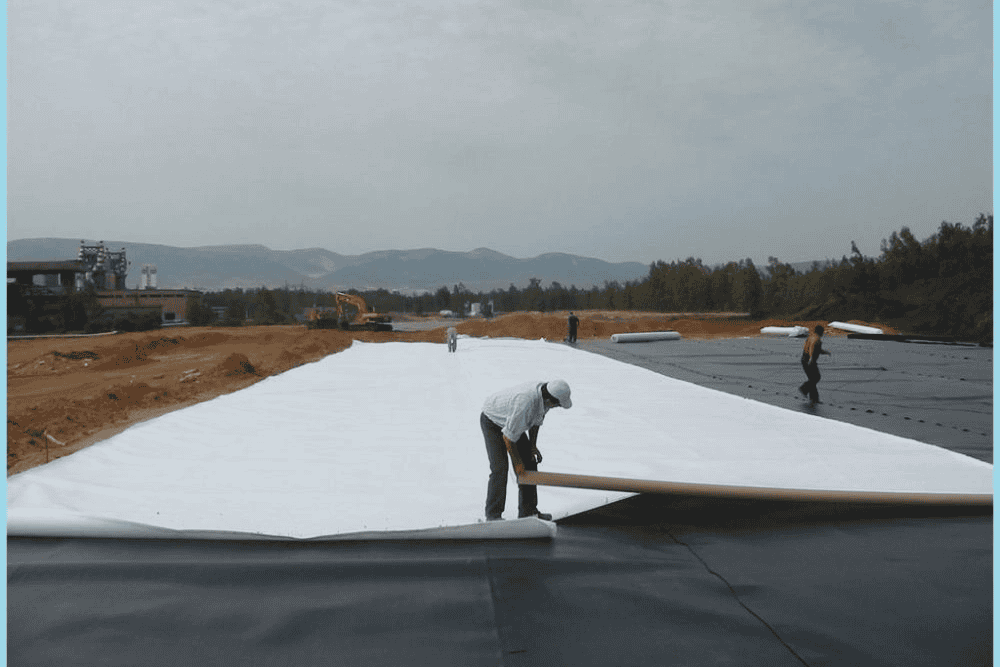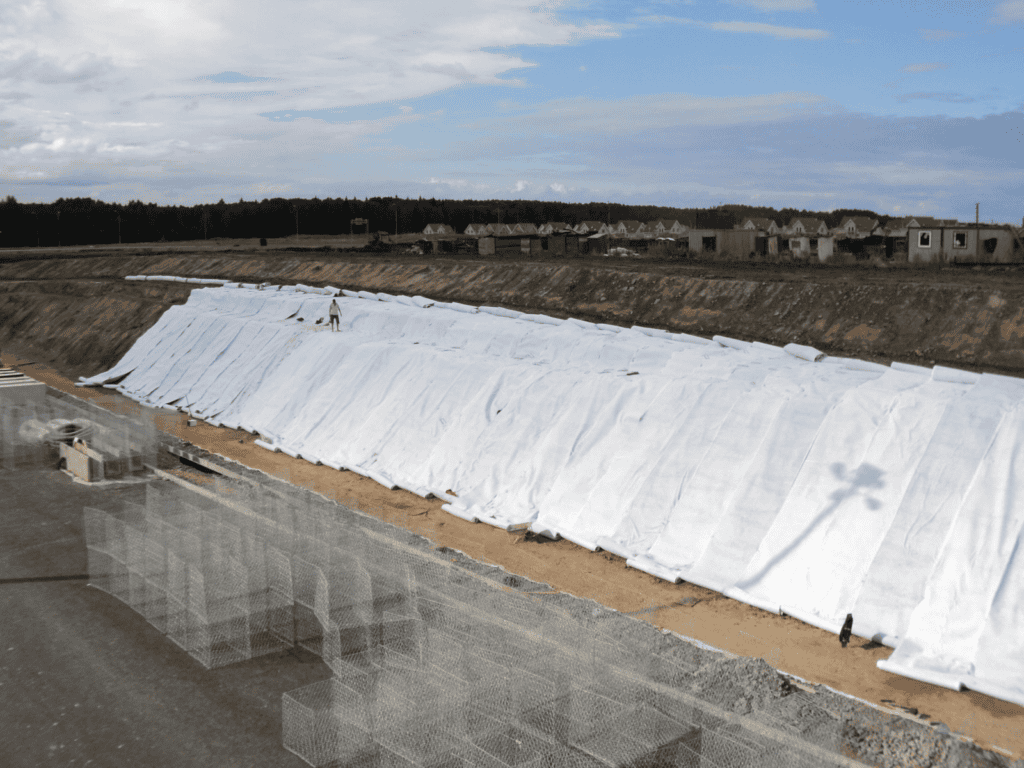As a basic civil engineering material, geofabric is widely used in various engineering constructions. In landfills and water conservancy projects, polypropylene short geofabric have become key materials for important functions such as anti-seepage, isolation, reinforcement and drainage due to their excellent performance. This article will conduct an in-depth analysis of the application fields, characteristics, case presentations and FAQs of polypropylene short geofabric to provide reference and guidance for engineering design and construction in related industries.

Main features of polypropylene short geofabric:
- High tensile strength: can withstand large external forces and enhance the stability of soil or engineering structures.
- Excellent filterability and water permeability: can effectively filter fine particles in the water flow while ensuring the flow of water.
- Corrosion resistance: polypropylene has good chemical corrosion resistance and can resist erosion by chemicals such as acids, alkalis, and salts.
- UV resistance: can resist UV degradation and is suitable for long-term application exposed outdoors.
- Good environmental adaptability: polypropylene short geofabric can work in various extreme climates, and its stable performance can be guaranteed from extremely cold to high temperature environments.
Application fields of polypropylene short geofabric;
Landfill
- Impermeability isolation: Geotextile can effectively isolate harmful substances inside the landfill from the external environment, prevent leachate from penetrating into groundwater, and thus prevent environmental pollution.
- Leachate collection and discharge: The combination of polypropylene short-filament geotextile and geomembrane, composite geotextile and other materials can effectively control the flow of leachate and ensure that the leachate is guided to the treatment facilities through the pipeline system.
- Enhance the stability of the landfill: Geotextile enhances the stability of the landfill soil, avoids soil instability caused by settlement or pressure, and reduces the deformation of the landfill structure.

Water conservancy projects
Water conservancy projects include projects such as dams, river management, and reservoir construction. The application of polypropylene short geofabric in water conservancy projects is mainly reflected in anti-seepage, reinforcement, drainage and filtration:
- Dam reinforcement and anti-seepage: Polypropylene short geofabric can be used as an anti-seepage layer for the reinforcement of dams and riverbanks to prevent water leakage. Its good tensile strength ensures that the dam will not be structurally damaged under the impact of water flow.
- River management and soil and water conservation: Geotextiles effectively prevent the scouring of river soil, reduce soil erosion, and maintain the stability of the river.
- Reservoir anti-seepage: The bottom and surrounding slopes of the reservoir are treated with polypropylene short geofabric for anti-seepage treatment to prevent water waste and soil infiltration, ensuring the long-term safe operation of the reservoir.

Road and railway construction Polypropylene short geofabric are mainly used to reinforce soil and prevent settlement in road and railway construction:
- Roadbed reinforcement: Geotextiles enhance the compressive strength of the roadbed and prevent soil settlement due to long-term load.
- Prevent soil and water erosion: Especially in ramps and bridge foundations, geotextiles can effectively prevent soil erosion and ensure the long-term stability of the road.

Construction and mining engineering In construction and mining engineering, polypropylene short geofabric are widely used:
- Basement waterproofing: Polypropylene short geofabric can be used as a waterproof layer for underground buildings to prevent groundwater from penetrating into the building.
- Mine tailings pond: In the construction of mine tailings pond, geotextiles prevent tailings leakage and pollution of the surrounding environment.

Practical application cases of polypropylene short geofabric
- Landfill anti-seepage project: In urban landfill projects, polypropylene short geofabric is widely used. The project established a complete anti-seepage system through the combination of geotextile and geomembrane to ensure that the leachate will not pollute the groundwater system. After several years of use, the discharge of leachate has been effectively controlled, the quality of groundwater has not been affected, and the project operation is stable, with significant economic and environmental benefits.
- Reservoir anti-seepage project: In large reservoir projects, polypropylene short geofabric is laid at the bottom and around the reservoir as an anti-seepage material. The project effectively prevents the waste of water resources by using a composite structure of geotextile and geomembrane. Especially in arid areas, the leakage problem of reservoirs has always been a management difficulty. After using polypropylene short geofabric, the leakage rate of the reservoir is significantly reduced, ensuring the safety and stability of the water source.
- River management project: In urban river management projects, polypropylene short-filament geotextile is used for soil protection and prevention of soil and water loss in rivers. By laying geotextiles, the erosion of soil by rainwater was reduced, the structural stability of the river channel was maintained, and the flood resistance capacity was improved. After the completion of the project, the water and soil conservation effect of the river channel was significant, the water quality was protected, and the surrounding environment was effectively improved.
Frequently Asked Questions (FAQ) about Polypropylene short geofabric
- What is the difference between polypropylene short geofabric and other types of geotextiles (such as polyester geotextile)?
Polypropylene short geofabric and polyester geotextile differ in material and performance. Polypropylene short-filament geotextile has strong corrosion resistance and low cost, and is suitable for use in environments such as landfills, while polyester geotextile performs well in high temperature environments and is suitable for special occasions. Both should be selected according to project requirements when used. - What is the service life of polypropylene short geofabric?
The service life of polypropylene short-filament geotextile is usually more than 20 years, and the specific life is related to factors such as construction environment, exposure degree, and ultraviolet radiation. In complex environments such as landfills and water conservancy projects, the durability of polypropylene short-filament geotextile is particularly important. - How to choose the specifications of polypropylene short geofabric?
The specifications of polypropylene short geofabric include width, thickness, tensile strength, etc., and the selection should be determined according to the specific requirements of the project. For example, the anti-seepage requirements of landfills may be higher, so it is necessary to choose geotextiles with thicker thickness, while in water conservancy projects, the tensile strength and UV resistance of geotextiles are more important. - How to ensure the quality of polypropylene short geofabric?
Choose a reputable supplier to ensure that the geotextiles meet relevant standards and quality certification requirements. At the same time, during the construction process, ensure that the geotextiles are laid without damage and the seams are properly handled to ensure the long-term performance of the geotextiles. - Can polypropylene short geofabric be recycled?
Yes, polypropylene short-filament geotextiles are recyclable






